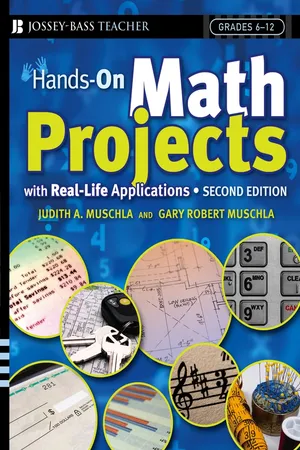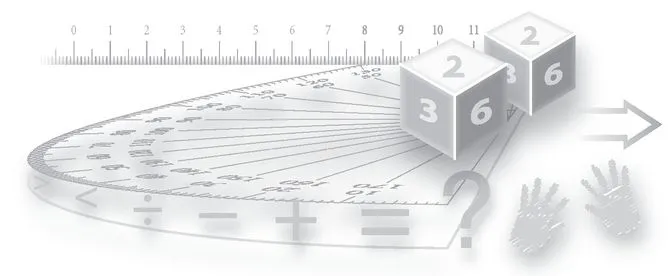![]()
Part One
Implementing Projects in the Math Class
![]()
Chapter One
Overview of projects in the math class
In a well-run math class, computation, problem solving, and critical thinking are all taught. Instead of learning skills in isolation, students learn math in context where they can see how it is applied in real situations. In this way they come to recognize the importance of math in their own lives. The connection between math and the real world is a strong one. This is especially true of math classes in which projects are a significant part of the curriculum.
Filled with activity and enthusiasm, a successful project-oriented math class is a center of individual learning, collaboration, cooperation, and sharing. Students work alone, together, and with the teacher. Along with learning fundamental math skills, students learn to think logically, analyze data, make decisions, and solve multifaceted problems that arise out of real-life situations. Students thus use the skills they are learning in meaningful ways.
Your Role
Your role changes when your students work on math projects. Along with your traditional responsibilities of introducing concepts, demonstrating skills with example problems, and grading the work of your students, you will become a facilitator and promoter. The horizons of your teaching will expand. More of your time will be spent working directly with individuals and groups. As students work on solving problems, you will circulate around the room, offering advice and suggestions, asking questions that lead to insights or direction, and giving encouragement and praise. Sometimes you may simply monitor a group’s efforts or model appropriate behavior. Occasionally you may need to pull a group back on task. (See “The Teacher’s Role During Math Projects.”)
There are many ways you can incorporate projects into your curriculum. While following your text, you can easily provide regular project activities. You may build time for projects into your schedule, for example, a day or two each week, or do units on projects a few times a year. Some teachers introduce a multistep project and then give students time to work on it at the end of class over the next few days. No matter how you provide the time, you should be consistent. Students not only need sufficient time for working on projects, they need to know when they will be working on them. This information enables students to come to class prepared and ready to work.
Supporting the Standards of the National Council of Teachers of Mathematics
The projects in this book support the Standards of the National Council of Teachers of Mathematics (NCTM), with specific emphasis on the following:
• The Problem-Solving Standard
• The Communication Standard
• The Connections Standard
• The Representation Standard
Problem solving is an essential part of learning mathematics. At its most basic, it requires students to find a solution to a problem without initially knowing what methods or procedures to use. As they seek a solution to the problem, students must draw on their own knowledge, experience, and skills. They may be required to assume various tasks, including conducting research, analyzing and organizing data, and drawing conclusions. In their efforts to discover answers, they reinforce previously learned skills, acquire new skills, and gain a greater understanding of mathematics. By presenting students with a variety of practical, engaging problems to solve, the projects contained in this book support the Problem-Solving Standard and foster the learning of valuable problem-solving skills.
The projects also support the Communication Standard. Because effective communication depends on clear thought and expression, communication encourages students to think critically, formulate their ideas, and express those
The Teacher’s Role During Math Projects
Since discovery is an important part of any project, you must encourage your students to assume much of the responsibility for their learning and progress. Your role changes. Along with your traditional duties, you will be spending some of your class time doing many of the following:
• Presenting multistep, critical thinking projects based on real-life situations
• Organizing and monitoring groups so that members work effectively together
• Modeling appropriate behavior and problem-solving skills
• Demonstrating to students what it is to be an enthusiastic problem solver by showing them how you are willing to tackle projects that at first may seem impossible
• Brainstorming with groups
• Guiding students in their research efforts
• Showing students that process is crucial to finding solutions
• Offering suggestions to solve problems
• Offering encouragement and applauding efforts
• Explaining that mistakes are merely stepping-stones to finding solutions and to learning
• Answering questions
• Helping students sort through their thoughts as they consider problem-solving strategies
• Showing students that various strategies may be used to solve the same problem
• Providing sufficient time for working on projects
• Monitoring student behavior and ensuring that classroom procedures are followed
• Keeping students on task
• Evaluating and assessing student progress
• Providing time for sharing results
ideas with mathematical precision. Communication gives students the opportunity to state their ideas, listen to the ideas of others, and compare them to their own, furthering their understanding of math. An important part of every project of this book is sharing results through formal and informal presentations.
Along with the Standards for Problem Solving and Communication, working on math projects supports the Connections Standard. Although students are often taught mathematical skills in isolation or in packets of information, mathematics is a broad, complex subject in which ideas are interconnected, extending throughout the field of math and to other disciplines. As they work on projects, students will find relationships among ideas that will broaden their understanding of problems and solutions, thereby gaining an appreciation of the scope of mathematics and how math is interwoven through all parts of society.
The projects of this book also support the Representation Standard. Mathematical ideas are represented with notations, symbols, and figures. Typical examples of representations include numbers, expressions, diagrams, and graphs. There are many more, of course. As students work on projects, they will express mathematical ideas as representations, which then become tools to explore, model, and develop mathematical concepts. An understanding of mathematical representations will serve students well in their continued study of math.
Perhaps one of the greatest benefits of using math projects in the classroom is how students must draw on numerous skills as they work toward solutions. When students work on math projects, they expand their view of math to real-life situations and develop skills that stretch well beyond the traditional curriculum. Such results support the Standards of the NCTM and enrich the mathematical experiences of students.
Strategies for Problem Solving
The math projects your students will be doing will require computation, analysis, problem-solving and critical thinking skills, and decision making. Since the type and nature of problems vary, there can be no set plan or step-by-step process they can use all the time. You should familiarize your students with various strategies that they can draw on as needed. Emphasize that strategies are methods or procedures that can be used alone or with other strategies. If a student should ask what strategy is best for solving a particular problem, a good answer is, “The one that works best for you.” You will likely find that different students will use different strategies to solve the same problem.
While some students may be quite adept at problem solving, many will need guidance, and you may wish to distribute copies of “Problem-Solving Strategies.” It is a guide that can help students get started in solving problems and keep them moving along.
There is also much you can do in regular lessons to help students acquire sound problem-solving skills that will be useful to them throughout their lives. See “Helping Students Develop Problem-Solving Skills” for a list of suggestions.
Problem-Solving Strategies
There are many ways to solve multistep problems. If you believe that there can be only one or two, you limit your options and reduce your chances of finding a solution. Following are some suggestions and strategies.
Before you begin seeking the solution:
• Make sure that you understand the problem. This may require rereading it several times.
• Be sure you understand the question and what answers you are seeking.
• Look for “hidden” questions.
• Find the important information that the problem provides, and eliminate information that is not essential. (Sometimes problems contain facts that you do not need.)
• Supply any missing information. You may need to research and analyze data.
• Make sure that you understand any special facts, data, or units of measurement.
As you seek a solution, consider all of these strategies:
• Look for patterns, relationships, connections, sequences, or causes and effects.
• Use guess and check (also called trial and error). Choose a place to start, try a solution, and see if it works. If it does not, try another.
• Organize your facts and information in a list. Sometimes this exercise can show relationships that you might otherwise overlook.
• Construct a table or chart. This is another way of identifying relationships.
• Think logically. Look for sequence and order.
• Rely on common sense. Some answers simply are not possible. Do not waste time pursuing them.
• Sketch or draw a model to help you visualize the problem.
• Simplify the problem by breaking it down into manageable steps. Solve a sub-problem...

